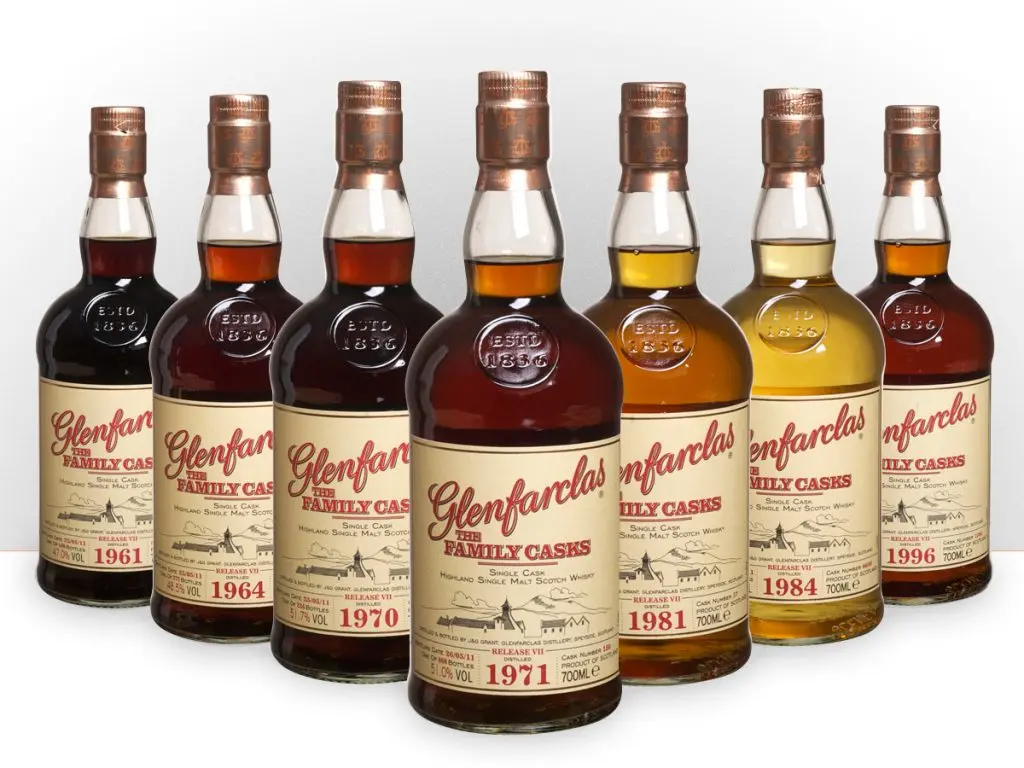Glenfarclas is the most traditional of all Scotch whiskeys: the technology has not been changed for 180 years, the malt is prepared at the same mill belonging to the same family, the water is still taken from the springs of Mount Ben Rinnes, the equipment at the distillery is not modernized. Rather, in the 80s of the last century, they tried to replace the method of heating the distillation cube: instead of an open gas burner, hot steam was used, as in most Scottish distilleries. But, as the director of marketing and sales of Glenfarclas Distillery Robert Rensom said: “The spirits were weaker and lost the characteristics characteristic of Glenfarclas.” Therefore, they returned to the old method with a burner inside the still. According to the same Robert Ransom, this whiskey only changed the label, and then only slightly.
Historical reference. It all started with the distillery – with the receipt of a license by its owner Robert Hay in 1836. But it is not worth considering this year as the date of birth of the brand, and even more so whiskey. In the modern office of Glenfarclas, a painting of a distillery hidden in the hills hangs in a place of honor and is dated 1791. Almost half a century before the license.
The whiskey recipe, which is known throughout the world as the Glenfarclas single malt, was created by specialists from two companies – Glenfarclas Distillery and Pattison, only in 1870. By that time, the distillery was already owned by John Grant, who bought it at a sale in 1865, along with a barley growing and processing farm.
Glenfarclas remains a Grant family company today. In 2013, sixth-generation George Grant, who previously worked for the company for 13 years as a sales director, became chairman of the board.
Interesting facts about Glenfarclas
- Glenfarclas Distillery’s 34 warehouses have been storing spirits since 1953. These are the oldest Scottish spirits, no brand has such stocks. It is their presence that allows the company to produce volume releases with 40-60 years of exposure.
- Glenfarclas’ management is mobile – the company quickly adapts to market demands, often pleases fans with new releases, and releases exclusive series for the countries with which it cooperates most closely. The main market for Glenfarklas is Germany, so for the Germans the number of limited editions is always significant – up to five per year.
- The distillery has very tall stills in which the vapors are recirculated: the light ones reach the top, the heavy ones flow down, condensing, and so on several times. Experts believe this process is the main reason for the soft taste of scotch.
- 90% of Glenfarclas spirits are matured in Oloroso and Fino Spanish sherry casks, while most companies use cheaper American whiskey casks.
- Glenfarclas Distillery produces 3,4 million liters of distillate per year.
Barrel business features
In the centuries-old history of Scotch whiskey, casks have been given, if not paramount, but always an important role. Very rarely brand new containers were used, more often those that arrived in Britain with wine, ale or American whiskey. The characteristic taste of dried fruit after aging in sherry casks was the reason for the complete transition of Glenfarclas to Spanish packaging in 1955. But then it was easier with barrels: the British always liked sherry, supermarkets bought it in huge quantities, and there were a lot of barrels. And Glenfarclas set up barter, supplying supermarkets with their whiskey in exchange for barrels.
Only in the 70s the situation became more complicated: wine was brought in plastic containers and there was a shortage. As a result, barrels became more expensive and they had to go to Spain. And now a barrel of bourbon costs 10 times less than a barrel of Oloroso, so the company still pours a small part of the spirits into containers from an American drink.
Glenfarclas tape range
There are many types of “Glenfarklas” – and “age” from 8 years old, and release, and collection, with a strength of 40 to 60%. Several releases are released annually for the general market and more than a dozen for countries where this drink is a constant success. Bartenders recommend drinking pure scotch as a digestif.
- Glenfarclas 12 Years Old (43%). Single malt scotch straw-golden color with a smooth sweet aroma without a hint of peat and smoke. The taste is slightly spicy, with hints of dried fruits and vanilla. Warm spicy aftertaste. In 2012, the drink received gold at the ISWC.
- Glenfarclas 15 Years Old (46%). Single malt whiskey of deep honey color with aromas of sherry, toffee and dried cherries. Sweetish taste with hints of sherry, barley malt and heather peat. Long warm and smoky aftertaste. In 2006, at the ISWC exhibition, it was named “Best Scotch aged in sherry casks”.
- Glenfarclas 40 Years Old (46%). The cognac-colored drink is due to the spirits that have matured in sherry casks since the late 60s. Light aroma with barely noticeable tart notes of leather. The taste is multifaceted, with hints of citrus and dark chocolate. Long warm aftertaste. This whiskey was first presented in 2011 at the Spirit of Speyside festival, where it received a 95 out of 100 from Malt Advocate editor John Hansell.










